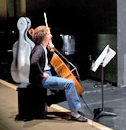Classical Music for Dummies, by David Pogue, Scott Speck, and Glenn Dicterow
One of the questions I get asked on a regular basis is “can you recommend a book for me that will teach me music basics?” I’ve finally come up with a good answer: Classical Music for Dummies.
I’m sure everyone’s familiar with this series “…..with more than 125 million books in print — For Dummies products show you how to do everything — cook, garden, manage finances, run a business, plan a trip, exercise, and eat right.” That’s what their website says. I’d never actually bought one of their books until I thumbed through this one on classical music because the titles seem more than a bit condescending. That being said, this is a really good book, especially if you like your information delivered with cute graphics, short sentences, and plenty of humor.
The table of contents includes The Entire History of Music in 80 Pages, A Field Guide to the Orchestra, and The Dreaded Music Theory Chapter. Getting past the titles, you find that the chapter on music theory is very well written. It’s specific, succinct, and thoughtfully organized. The sections about the different instruments of the orchestra are also terrific, with information on how each instrument is played, and mention not only of famous pieces featuring that instrument, but lesser-known works as well. Sidebars in the text give further explanations, such as “making an oboe reed at home,” which ends with the advice to “repeat several hundred thousand times over a 20-year period until you have the perfect knack.”
(Being a natural-born stickler for details, I found a few minor errors in the book. The authors claim that gut strings were made of cat-gut, while most resources I’ve encountered say that gut strings are made from sheep intestine. The paragraph on rosin is also misleading: “Rosin is a chalky powder that comes in the form of an amber-colored, often circular block.” Another paragraph that troubled me states that a brass instrument can be disassembled and cleaned in a dishwasher (!) Perhaps that’s possible, but I doubt it’s recommended. At least not by serious brass players.)
One of my favorite chapters in the book is a semi-fictional account of what it’s like to take an audition. The authors follow a woman to a major flute audition and describe her prior experiences, her preparation, and her actual audition—including unexpectedly encountering her ex-husband at the audition! (She doesn’t win the job, but neither does he). It’s one of the most authentic descriptions I’ve ever read of the audition experience.
The book comes with a CD, and Chapter 5 in the text is a detailed guide to the pieces on the CD and specific things to listen for in each piece: “2:59 Here suddenly is Theme B.” As you’d expect, the pieces included are standard repertoire, but they are excellent choices for someone just beginning to explore classical music.
To summarize: If someone asks you to recommend a book on music basics, you can sagely recommend this book to them.


No comments yet.
Add your comment